The interesting history of potatoes: 'Devil's apple' brings prosperity to the empires
The reason? Potatoes are not a native food crop in Europe. Therefore, it does not appear in the Bible. Originally brought by the Spaniards from their invasion of the Inca Empire in South America, potatoes naturally introduced into France.
But the French believe that the potato caused lepers to eat. The Church says God does not want people to use potatoes as food. Because of that, the French people were afraid of eating potatoes as if they were afraid of witchcraft.
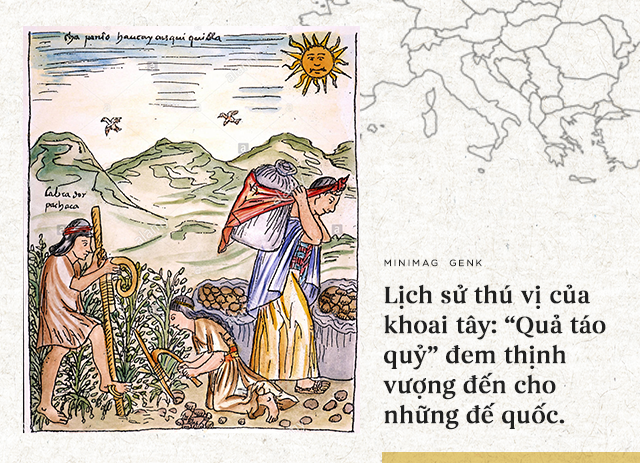
History only changed after Antoine-Augustin Parmentier, a pharmacist convinced the French to grow potatoes. He had to resort to hundreds of thousands of plans, taking advantage of the royal family members to make this tree popular.
When famine raged in Europe from the 16th to 19th centuries, the whole continent simply could not support itself. In the end, the potatoes saved everything. Not only that, the sacred tree of the Incas also brought prosperity, promoted industrial revolution, nourished the army and turned European countries into mighty empires.
Today, the total potato production of the whole of Europe is about 52 million tons per year. The figure of France alone is 8 million tons.

The story of the potato dates back to about 13,000 years ago in South America, when the cultivar grew wildly in the mountains of the Andes, southern Peru and northeastern Bolivia today.
Geographically, Andes is not a place to cultivate a major food crop. It is the longest mountain range on the planet, higher than 6,700 m and shielded into a strip of 8,850 km on the Pacific Rim.
There are many active volcanoes scattered across the Andes, the result of frequent geological faults that propel the area in the face of earthquakes, flash floods and landslides. Even in the most peaceful days, the Andes' climate is still very harsh for a food crop to thrive.
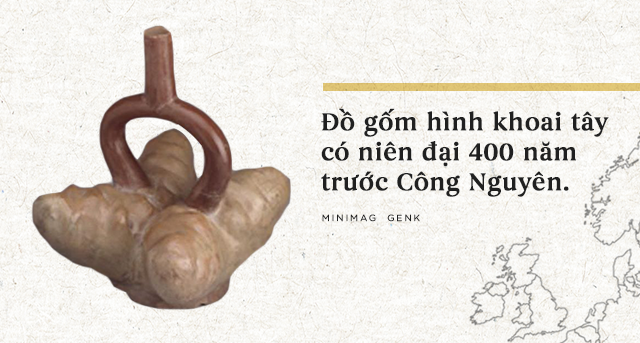
Mountain temperatures can range from 24 ° C to freezing within just a few hours. The air is too thin to hold the heat. In such a region, only maize, quinoa and potatoes can grow.
The Incas were the first people to tame the potato and turn it into a major food crop. Archaeological sites indicate that the potatoes were buried with the Incas by the dead 4,500 years ago. And the potato-shaped pottery, dating back to 400 BC found in Peru also confirmed the Inca's cult of this food crop.
Also, because of the potatoes, the Incas built a mighty empire in South America. This starchy root provides them with energy to conquer and annex surrounding tribes, corn-eating peoples.
The Incas also devised a method of storing the potato frozen, protecting it from mold, rodents and preventing potato germination. In this way, potatoes can be stored for years without losing nutritional value.
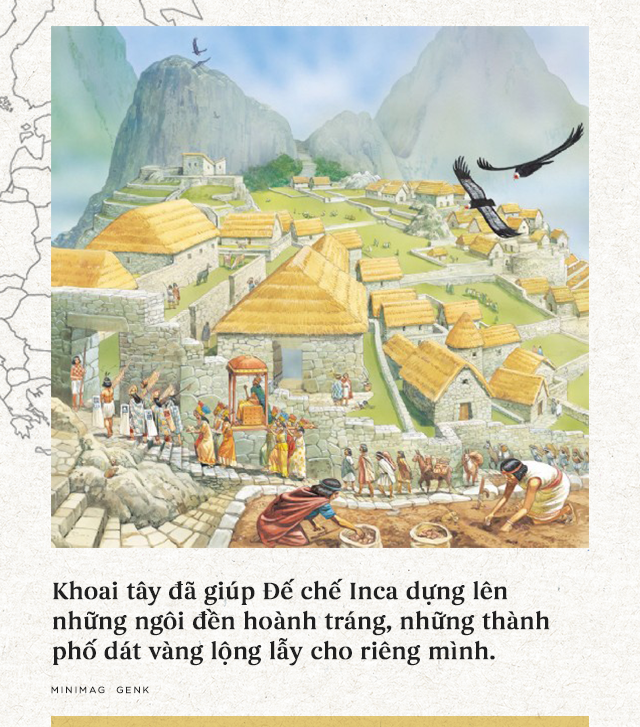
And because of that, potatoes became a "coin" in the empire. The Incas could collect taxes from farmers with potatoes, store them in food stores, and disburse them to soldiers, builders and slaves.
While the Egyptians planted wheat and barley to build the great pyramids, the potatoes helped the Inca Empire erect magnificent temples and gold-plated cities of its own.

At the height of the 15th century, the Inca Empire began to weaken as it entered the 16th century, which was also the time when the first Europeans discovered America and introduced new pathogens into the continent. Measles and smallpox have spread from Central America into the Inca, causing deadly epidemics that cannot be cured.
The landmark of 1532 officially marked the fall of the empire, after Francisco Pizarro González, a Spanish explorer with 186 entourage landed on what is now Peruvian coast.
They kidnapped King Atahualpa of Inca, plundering temples and treasures throughout the empire. After filling a room filled with jewels, the Spaniards did not forget to throw in the boat some " truffles ", potatoes as they called them, they wrinkled, covered with mud. Nothing looks precious. Crossing the Atlantic, the first potatoes were introduced to Europe.
Historical studies estimate that, during his raid in Inca, the Spaniards earned an amount of gold and silver equivalent to 45 million euros at the present time. But few would have expected, the most precious thing they brought back was not the treasure, but a few potatoes thrown on the floor.
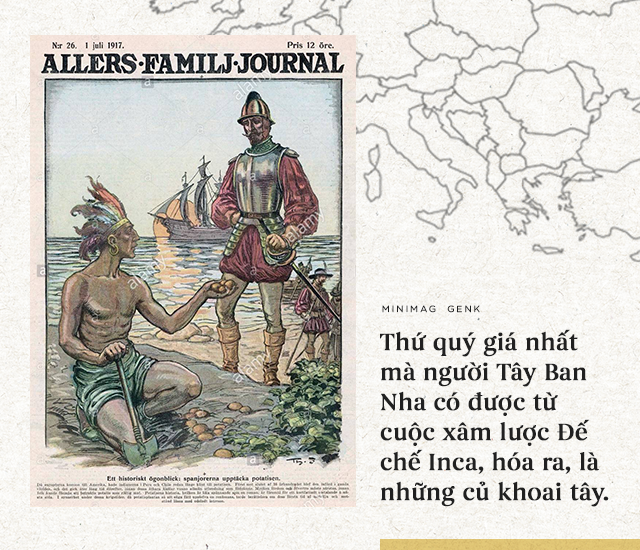
Once brought to the Inca Empire, potatoes continue to " spread " its prosperity to the countries of Europe, turning them into empires. But things did not happen overnight.
When the Spaniards brought back from South America, the potatoes received only wary eyes. In 1570, some Spanish farmers began experimenting with small-scale potato cultivation. But after harvesting, its tubers are mainly used as feed for pigs.
Late in the 16th century, potatoes found their way to Italy. By the early 1600s, it was present in Austria, Belgium, the Netherlands, Switzerland, England, Germany, Portugal, Ireland and France. But nowhere is this plant welcome.
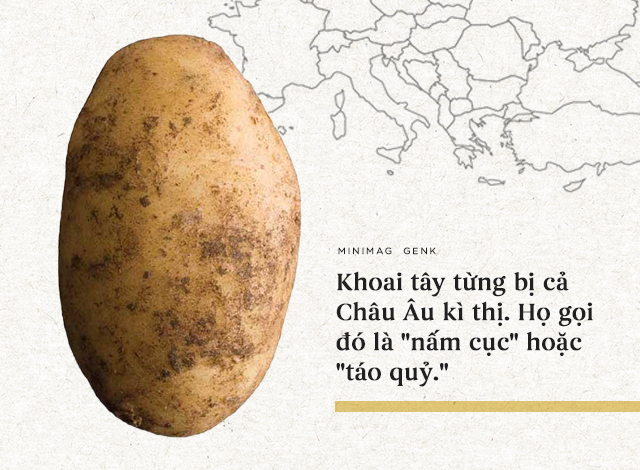
Native to South America, potatoes of course do not appear in the Bible. That's why the Catholic Church thinks that God doesn't want people to eat potatoes.
Moreover, this plant has distinct characteristics that are completely different from the knowledge of Europeans. It does not grow from seeds, but grows from tubers.
If a farmer buried an entire potato in the ground, it would sprout and grow into a new potato plant. If they cut one bulb into quarters, they would have up to four seedlings. This peculiarity caused the potato to be given the name " evil apple ", wrinkled apples proliferate in the ground.
Another strange thing is that potatoes do not breathe at night. European botanists have finally identified the plant as a nightshade, a often toxic plant. Because of this, potatoes are often banned or restricted to herbal gardens.
The first trials of potato consumption in Europe didn't end very well. Because people eat only potatoes that grow up from the ground, that is, when they sprout, they are often poisoned. Some scientists even claim that potatoes are the cause of leprosy, just because its tubers look distorted like those infected.
Denis Diderot, a French philosopher once wrote in the Encyclopedia (1751-1756), the first book that summarizes the enlightening ideas in Europe: " Regardless of how you cook potatoes, the root Its also a powdered and tasteless powder food . "
Diderot sees potatoes as just a food for those who " eat to live ". Farmers, the army in famine can eat potatoes. It is a bloating food, but can provide energy to help them survive.
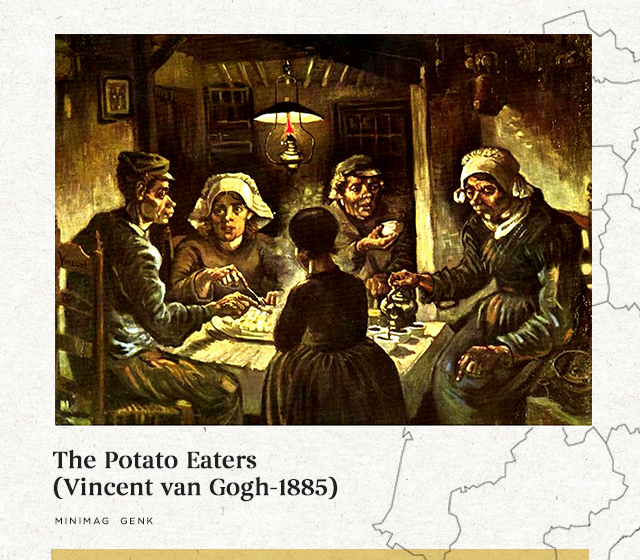
Hunger, it turned out, was the only chance the potato could rise to compete with wheat in Europe. Back then, hunger was something permanent on this continent.
According to the historian Fernand Braudel, France suffered more than 40 famines on a national scale, between 1500 and 1800. England also fell into a similar situation, with 17 national famine from 1532 to 1623. The whole continent simply could not support itself.
Frederick the Great, the king of Prussia, was the first to realize the potential of potatoes to fight hunger. In 1756, Frederick issued the Kartoffelbefehl decree, or the " Potato Act ", forcing all his subjects to grow this plant.
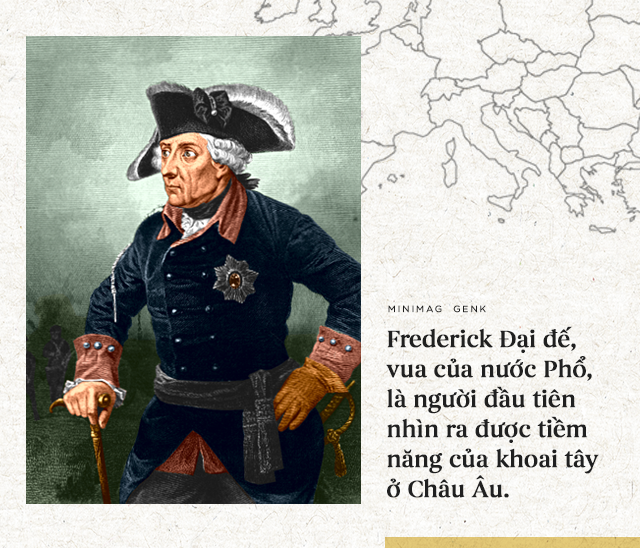
It was Frederick who spread the word " potato " to replace the name that farmers call this "truffles ".
The implementation of the original decree did not go smoothly. In Prussia there was a saying, " It's der Bauer nicht kennt, frisst er nicht ", meaning " Something a farmer doesn't know what it is, he won't eat".
Kolberg, a town even responded to the king's decree: " That thing [potatoes] has no smell, no taste, even dogs don't even crave them, so what is the use of them? with us? ".
In response to this opposition, Frederick devised a plan. He has grown immense potatoes on the royal farms in the area of Berlin now. Afterwards, Frederick sent a guard to guard the field.
Knowing the psychology of the people, whatever was strictly protected, they would think it was precious, Frederick the Great instructed the guards to pretend to sleep or to neglect their duties frequently. This has really caught the attention of thieves.
Every night, thieves come to the royal field to steal potatoes. Soon, this species was sold flooding the black market. The farmers returned to care about the potato because it was priced well. And so this tree has successfully invaded every garden in Prussia, saving lives through unsuccessful wheat crops.
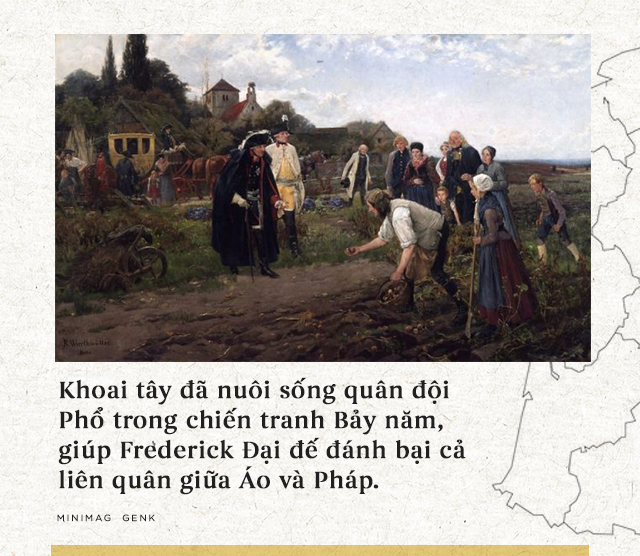
Potatoes with easy-to-grow, easy-to-preserve and energy-rich properties were the food that sustained the Prussian army during the Seven-Year War (1756-1763), helping Frederick the Great to defeat both coalitions between Austria and France .

Antoine-Augustin Parmentier joined the French army during the Seven-Year War, serving as a military physician. At a time when the French army was defeated by Frederick the Great, the potato was still a food for pigs to them.
But when Parmentier was taken prisoner in Prussian barracks and reluctant to eat potatoes, he realized that the plant was not poisonous, the French conception of potatoes was actually not right. . Potatoes being estranged, forbidden to grow and only feeding pigs in France were feeding and giving the Prussians an advantage.
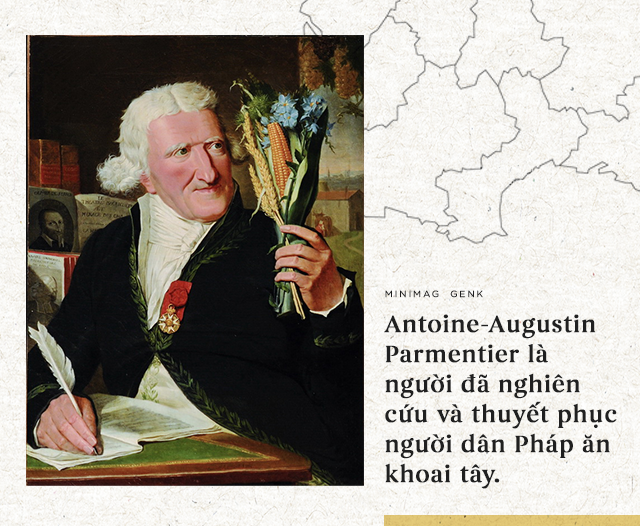
During the three years he was imprisoned in Prussia, Parmentier found he could still eat potatoes to survive, even to stay healthy without getting sick. So when he was released to return to France in 1763, he used the knowledge of a pharmacist to focus on this plant.
What Parmentier found was that the potatoes were not poisonous, provided that the people ate only the rooted bulbs. On the same cultivated area, potatoes can provide 2-4 times more calories than other grains. Parmentier realized it was a great food, the only problem was that the French people would not eat it.
To turn things around, Parmentier is said to have adopted a similar strategy as Frederick the Great. He planted potato gardens and had people pretend to protect them. But with his intelligence Parmentier knew the work had to be done from the top down.
He continually took the results of his research to persuade doctors, scientists, nobility, and the royal family of the benefits of potatoes. Cheerful and open, almost all became " KOL " in Parmentier's clever " marketing " campaign for potatoes.
The story goes that when King Louis XVI and Queen Marie Antoinette strolled in the garden of Versailles, Parmentier picked each person a potato flower. Queen Antoinette had put a purple flower on her hair and the king put it on his button.
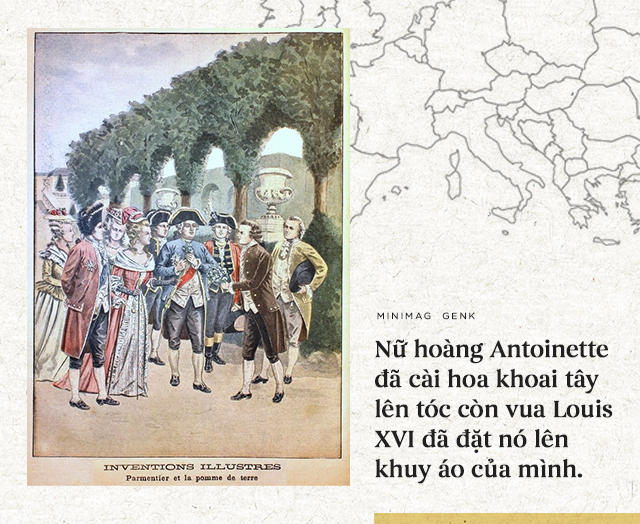
When King Louis XVI asked Parmentier about the tree, he asked for a piece of the royal estate to grow potatoes. The courtiers then imitated the king. News spread to win the public's curiosity. And this is Parmentier's reenactment of what Frederick the Great did in Prussia.
He let the soldiers spread outside Paris, planted potato fields, and pretended to guard. The people then stole the potatoes and brought them to their home gardens.
By 1793, Parmentier continued to write and print 10,000 copies of potato planting manuals to be distributed to every commune in French territory. He also released " National Cooking, " which contains more than 20 recipes for making potatoes, making it more delicious and conquering the taste of the French.
And as you might guess, this book teaches the French how to make the legendary French fries , " French fries ":
" First, combine the potato, egg and water flour together. Then add one teaspoon of oil, one teaspoon of eau de vie (wine), salt and pepper. Beat the mixture until there is no lump. Now peel the potatoes, cut them into slices, then soak them in dough. Finally, remove them and fry them until the potatoes have a nice color . "
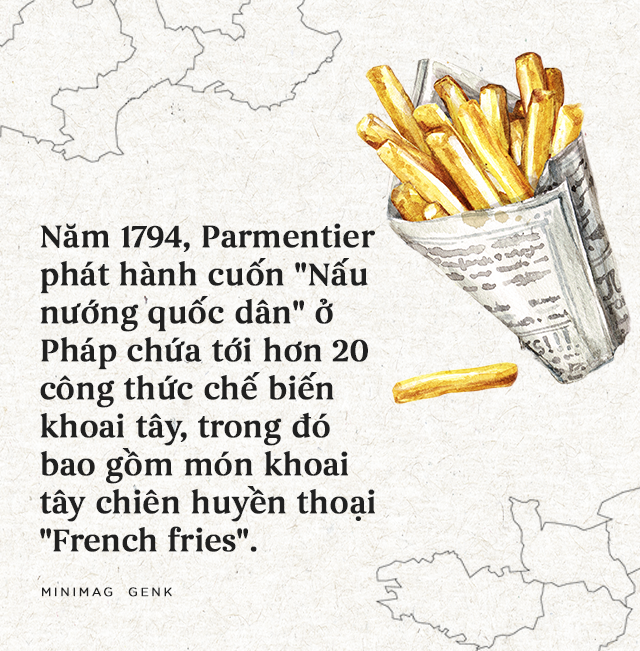
Before potatoes became popular in France, farmers produced just enough grain to feed the country each year, as long as nothing happened to their crops. Unfortunately, those are the most common things. Crop failures, natural disasters and even wars often make food supplies in France extremely precarious.
Hundreds of famines have occurred on a local scale. On average every 7 years, France will face a famine on a national scale. The arrival of potatoes finally solved the food problem for France.
Only after that basic problem was solved did France progress to the Revolution (1789-1799) and then the wars of Napoleon (1803-1815).
A supporter of the idea of a subsistence Republic, Napoleon encouraged the cultivation of potatoes. Immediately, the French potato production increased to 15%.
The French allies looked at the lesson that the potato was also widely applied, even their enemies followed. By the final years of the Napoleonic War, potatoes were a staple in the diet of most Europeans.

Commenting on this historical period, Christian Vandenbroeke, a Belgian historian once said: " For the first time in Western European history, a definitive solution to the food problem was proposed."
A single acre of potato and cow's milk can now support an entire family, providing all the vitamins and micronutrients needed for a healthy diet. Potatoes are so rich in vitamin C that they have helped stop scurvy that once spread throughout the continent.
It has solved all famine on a 2,000-mile stretch of land stretching from Ireland to the Ural Mountains of Russia. Finally, the continent can make its own dinner.
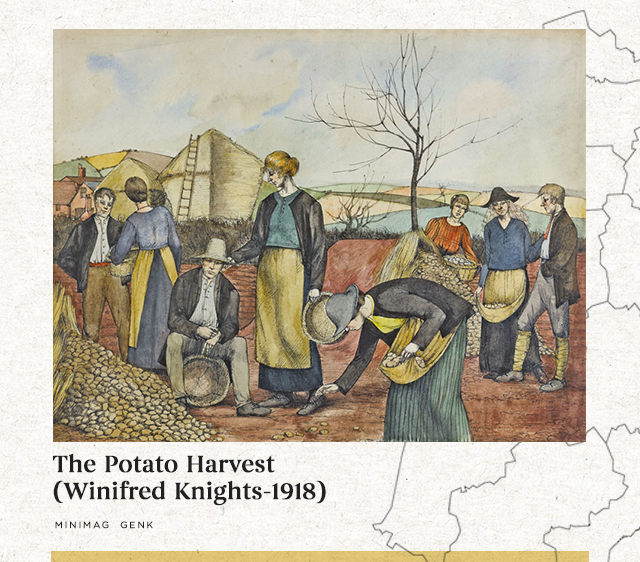
In addition to addressing hunger, potatoes are a staple food that has helped the whole of Europe prosper. The rapid increase in food sources has led to population growth. This was once mentioned by economist Adam Smith in his classic book, " The Wealth of Nations ."
The most impressive example of the potential of potatoes in changing the population pattern occurred in Ireland, where potatoes became a staple food in 1800. About 40% of the Irish population does not eat regardless of a type Solid foods other than potatoes. And in just over 60 years, from 1780 to 1841, their population doubled to 8 million.
It is worth noting that this is not the result of industrialization or agricultural technical reform. That is the only consequence of growing potatoes. Although Ireland had a very old-fashioned land tenure practice in comparison to Europe at that time, the superior characteristics of the potato allowed even one of the poorest farmers in the country to grow it.
Without any heavy investment or labor, potatoes are something children can grow, harvest and process. It also does not require cutting, milling or grinding like wheat. Potato prosperity has significantly reduced infant mortality, encouraged early marriage and increased population.
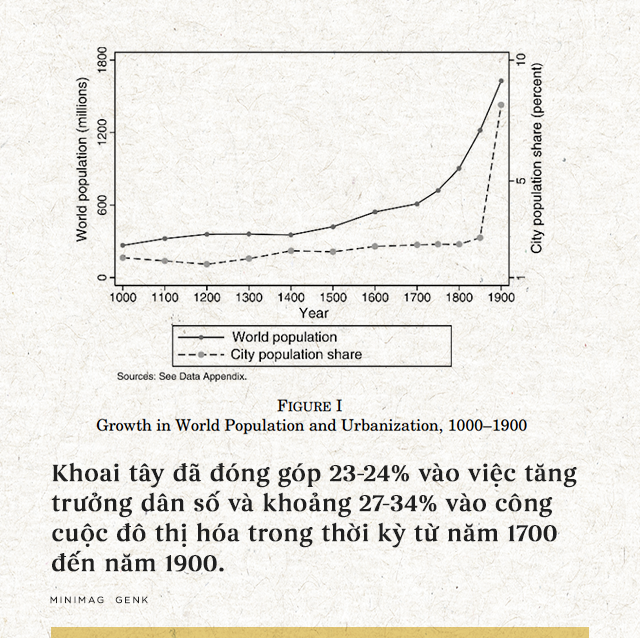
Nancy Qian and Nathan Nunn, economists at Yale University and Harvard, conducted a study on the effect of potatoes on population explosion in Europe. They compared population growth in 132 countries before and after 1700.
Statistical results show that the population of Europe jumped from 126 million in the early 18th century to 300 million in the early 20th century. Where potatoes are grown the most is where population growth is high. Best. For the first time in history, the booming population did not create mass famines, but simply pushed people into cramped cities.
According to Qian and Nunn, potatoes contributed 23-24% to population growth and about 27-34% to urbanization between 1700 and 1900.
Population growth and urbanization have spurred the pace of the industrial revolution, especially new industries dependent on fossil fuel mining.
Potato was then likened to a second type of coal, because it nurtured the main workforce that contributed to this innovation. William Hardy McNeill, historian and author of " The Rise of the West " once remarked:
" Just by providing a living wage, or something very close to the subsistence cost, a large number of rural migrants will be available to control new and real machines. present all the difficult tasks of serving an urbanized society ".
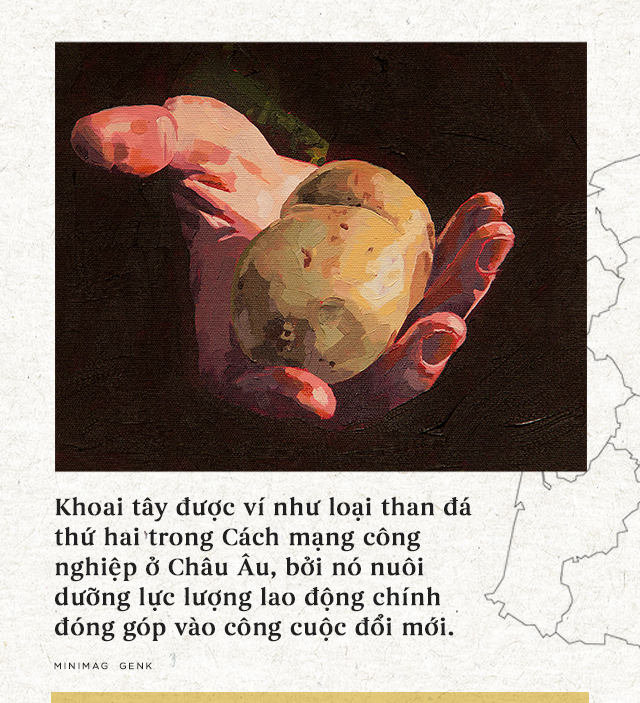
And as a natural formula, the thriving population in Europe after the potato crops will fill the ranks of the army and imperial navy, giving them victories in far-flung lands, pushed millions of migrants out into colonies and into eastern Siberia.
" Certainly, without potatoes, Germany could not become the leading industrial and military power in Europe after 1848. Russia could not vaguely threaten the eastern border of Germany." 1891, "argued McNeill.
Like the way the Incas had grown into a powerful empire in South America, since the mid-18th century, potatoes again turned a number of European nations into world ruling empires.
"In short, all of the continent's dominant properties for two centuries, from 1750 to 1950 including the expansion and colonial struggle of overseas empires, the process of their immigration into the United States. The United States, like other parts of the world, basically comes from the fact that potatoes have expanded their food supply in Northern Europe, "McNeill said.
This is the second time potatoes have played an important role in changing human society around the world.
You should read it
- Not only can lighting LEDs, potatoes can be made into a self-driving car running at 7.3m / day.
- The great benefits of sweet potatoes that you don't know yet
- Science test: Potatoes can be grown on Mars
- How to make moon cakes of purple sweet potatoes for people who are afraid of fat
- 12 super foods you should have on the menu
- Pocket the address to buy the best French Press French coffee maker
- French alphabet and standard pronunciation
- 10 most pesticide-free vegetables and fruits
May be interested
- How to buy Vietnamese Empire Empire 4K only 115,000 VND
 microsoft has launched a 4k empire purchase program for vietnamese gamers at a price of only 115,000 vnd, with 4k resolution, the sound is significantly improved for players.
microsoft has launched a 4k empire purchase program for vietnamese gamers at a price of only 115,000 vnd, with 4k resolution, the sound is significantly improved for players. - How to download and play Age of Empires IV for free on PC
 good news for those who are planning to buy the copyrighted game age of empires iv on steam, this platform is currently allowing users to download and play age of empires iv for free on pc. empire version with sharp 4k graphics.
good news for those who are planning to buy the copyrighted game age of empires iv on steam, this platform is currently allowing users to download and play age of empires iv for free on pc. empire version with sharp 4k graphics. - Not only can lighting LEDs, potatoes can be made into a self-driving car running at 7.3m / day.
 the experiment to generate electricity from potatoes to light a small bulb is no longer strange to many people, but making a self-driving potato like a self-propelled car is amazing.
the experiment to generate electricity from potatoes to light a small bulb is no longer strange to many people, but making a self-driving potato like a self-propelled car is amazing. - A young man used 770 pieces of moldy potatoes to play Doom 1993 on a handheld computer
 youtuber equalo recently posted a video showing him using 770 pieces of moldy potatoes to run a basic handheld computer ti-84 and play doom 1993 - the grandfather of fps games.
youtuber equalo recently posted a video showing him using 770 pieces of moldy potatoes to run a basic handheld computer ti-84 and play doom 1993 - the grandfather of fps games. - Tips for playing Ravenous Devils - horror restaurant management game
 tips for playing ravenous devils - a horror restaurant management game, ravenous devils tips for beginners, helping to manage a restaurant full of horror and horror
tips for playing ravenous devils - a horror restaurant management game, ravenous devils tips for beginners, helping to manage a restaurant full of horror and horror - Van prayed to Than Tai on the 10th of every month
 shen yun is the god who brings fortune. so all houses, shops, companies, ... worship this god to pray for a new year of prosperity, prosperity, money like water, special drip money of the day. shen tai, january 10 lunar calendar.
shen yun is the god who brings fortune. so all houses, shops, companies, ... worship this god to pray for a new year of prosperity, prosperity, money like water, special drip money of the day. shen tai, january 10 lunar calendar. - Quickly register to play Age of Empires 4K upgrade version of the graphic
 a very happy news for vietnamese gamers, especially those who love aoe games (empire), you can sign up to play age of empires upgraded version of 4k graphics at this very moment. .
a very happy news for vietnamese gamers, especially those who love aoe games (empire), you can sign up to play age of empires upgraded version of 4k graphics at this very moment. . - Age of Empires Mobile officially launches on iOS and Android
 microsoft corporation has just brought great news to those who love the game age of empires when they are about to release a mobile version of the popular game on the two most popular platforms today, ios. (apple) and android (google).
microsoft corporation has just brought great news to those who love the game age of empires when they are about to release a mobile version of the popular game on the two most popular platforms today, ios. (apple) and android (google). - Cheat Age of History 3, full AOH III cheat code
 using age of history 3 cheats brings many benefits to players, such as helping you quickly build an empire without spending too much resources and time. you can experiment with different strategies without worrying about losing.
using age of history 3 cheats brings many benefits to players, such as helping you quickly build an empire without spending too much resources and time. you can experiment with different strategies without worrying about losing. - How to get free Gems in Empires & Puzzles
 do not rush to top up the game empires and puzzles because there are quite a few ways to get free gems in empires & puzzles and the article below will list all the methods that you can apply.
do not rush to top up the game empires and puzzles because there are quite a few ways to get free gems in empires & puzzles and the article below will list all the methods that you can apply.










 Dymaxion: How the 30s car with its strange design changed the face of the entire car industry
Dymaxion: How the 30s car with its strange design changed the face of the entire car industry Discovered animal bones, stone tools 45,000 years old in ancient Chinese caves
Discovered animal bones, stone tools 45,000 years old in ancient Chinese caves The 7,000-year-old architecture is found in western Iran
The 7,000-year-old architecture is found in western Iran 530 million year old fossils have eyes like bees, dragonflies today
530 million year old fossils have eyes like bees, dragonflies today The 1,600-year Roman tomb with ancient coins was discovered in Somerset
The 1,600-year Roman tomb with ancient coins was discovered in Somerset Pre-Hispanic Temple of Wari civilization is found in Peru
Pre-Hispanic Temple of Wari civilization is found in Peru